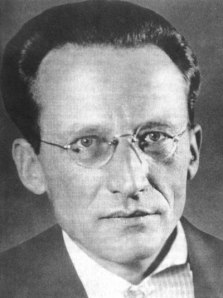
Erwin Schrödinger. Discussions of quantum foundations often seem to involve his much abused cat.
The group of physicists seriously engaged in studies of the “foundations” or “interpretation” of quantum theory is a small sliver of the broader physics community (perhaps a few hundred scientists among tens of thousands). Yet in my experience most scientists doing research in other areas of physics enjoy discussing foundational questions over coffee or beer.
The central question concerns quantum measurement. As often expressed, the axioms of quantum mechanics (see Sec. 2.1 of my notes here) distinguish two different ways for a quantum state to change. When the system is not being measured its state vector rotates continuously, as described by the Schrödinger equation. But when the system is measured its state “collapses” discontinuously. The Measurement Problem (or at least one version of it) is the challenge to explain why the mathematical description of measurement is different from the description of other physical processes.
My own views on such questions are rather unsophisticated and perhaps a bit muddled:
1) I know no good reason to disbelieve that all physical processes, including measurements, can be described by the Schrödinger equation.
2) But to describe measurement this way, we must include the observer as part of the evolving quantum system.
3) This formalism does not provide us observers with deterministic predictions for the outcomes of the measurements we perform. Therefore, we are forced to use probability theory to describe these outcomes.
4) Once we accept this role for probability (admittedly a big step), then the Born rule (the probability is proportional to the modulus squared of the wave function) follows from simple and elegant symmetry arguments. (These are described for example by Zurek – see also my class notes here. As a technical aside, what is special about the L2 norm is its rotational invariance, implying that the probability measure picks out no preferred basis in the Hilbert space.)
5) The “classical” world arises due to decoherence, that is, pervasive entanglement of an observed quantum system with its unobserved environment. Decoherence picks out a preferred basis in the Hilbert space, and this choice of basis is determined by properties of the Hamiltonian, in particular its spatial locality.
Continue reading
